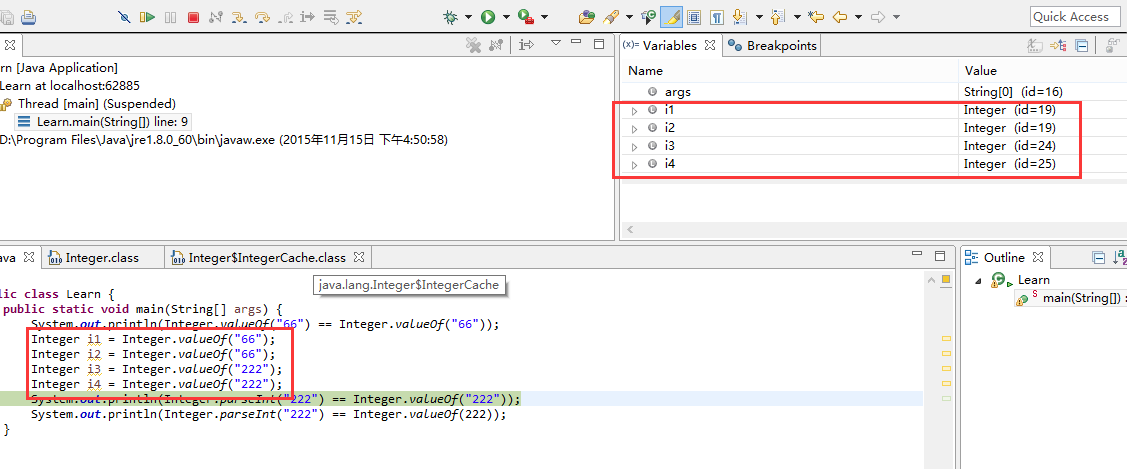最近用 Java 刷算法题的时候发现 Integer 有一个小坑,我把当时的代码简化如下:
public class Learn {
public static void main(String[] args) {
System.out.println(Integer.valueOf("66") == Integer.valueOf("66"));
System.out.println(Integer.valueOf("222") == Integer.valueOf("222"));
System.out.println(Integer.parseInt("222") == Integer.valueOf("222"));
}
}我电脑 JDK 的版本是1.8的,大家猜猜在我电脑上的输出结果是啥?
true
false
true
可能有个朋友遇到过这个问题,但我是没有的哈,当时我人傻掉了…………
本着学习和解决 Bug 的心态,我点开了 Integer 类的源码发现了问题所在:
Integer.valueOf()
我首先点开了 Integer.valueOf(String s) 方法一探究竟,然后发现:
public static Integer valueOf(String s) throws NumberFormatException {
return Integer.valueOf(parseInt(s, 10));
}Integer.valueOf(int i):
public static Integer valueOf(int i) {
if (i >= IntegerCache.low && i <= IntegerCache.high)
return IntegerCache.cache[i + (-IntegerCache.low)];
return new Integer(i);
}parseInt():
public static int parseInt(String s, int radix)
throws NumberFormatException
{
/*
* WARNING: This method may be invoked early during VM initialization
* before IntegerCache is initialized. Care must be taken to not use
* the valueOf method.
*/
if (s == null) {
throw new NumberFormatException("null");
}
if (radix < Character.MIN_RADIX) {
throw new NumberFormatException("radix " + radix +
" less than Character.MIN_RADIX");
}
if (radix > Character.MAX_RADIX) {
throw new NumberFormatException("radix " + radix +
" greater than Character.MAX_RADIX");
}
int result = 0;
boolean negative = false;
int i = 0, len = s.length();
int limit = -Integer.MAX_VALUE;
int multmin;
int digit;
if (len > 0) {
char firstChar = s.charAt(0);
if (firstChar < '0') { // Possible leading "+" or "-"
if (firstChar == '-') {
negative = true;
limit = Integer.MIN_VALUE;
} else if (firstChar != '+')
throw NumberFormatException.forInputString(s);
if (len == 1) // Cannot have lone "+" or "-"
throw NumberFormatException.forInputString(s);
i++;
}
multmin = limit / radix;
while (i < len) {
// Accumulating negatively avoids surprises near MAX_VALUE
digit = Character.digit(s.charAt(i++),radix);
if (digit < 0) {
throw NumberFormatException.forInputString(s);
}
if (result < multmin) {
throw NumberFormatException.forInputString(s);
}
result *= radix;
if (result < limit + digit) {
throw NumberFormatException.forInputString(s);
}
result -= digit;
}
} else {
throw NumberFormatException.forInputString(s);
}
return negative ? result : -result;
}从代码上我们可以知道两件事:
Integer.valueOf(String s) 方法将字符串 s 交给 parseInt 方法处理,将其转换为十进制整数后,传给 Integer.valueOf(int i) 方法处理该字符串代表的整数
当传入数字处于[IntegerCache.low, IntegerCache.high]这个区间时,将直接返回一个数值。
那我们来看看[IntegerCache.low, IntegerCache.high]区间长度是多少吧:
private static class IntegerCache {
static final int low = -128;
static final int high;
static final Integer cache[];
static {
// high value may be configured by property
int h = 127;
String integerCacheHighPropValue =
sun.misc.VM.getSavedProperty("java.lang.Integer.IntegerCache.high");
if (integerCacheHighPropValue != null) {
try {
int i = parseInt(integerCacheHighPropValue);
i = Math.max(i, 127);
// Maximum array size is Integer.MAX_VALUE
h = Math.min(i, Integer.MAX_VALUE - (-low) -1);
} catch( NumberFormatException nfe) {
// If the property cannot be parsed into an int, ignore it.
}
}
high = h;
cache = new Integer[(high - low) + 1];
int j = low;
for(int k = 0; k < cache.length; k++)
cache[k] = new Integer(j++);
// range [-128, 127] must be interned (JLS7 5.1.7)
assert IntegerCache.high >= 127;
}
private IntegerCache() {}
}分析上面的代码,IntegerCache 是一个私有的静态内部类,它作为 Integer 类的静态缓存类被 Integer 使用,当我们需要使用的整数数值处于[-128, 127]之间时,不需要重新生成一个 Integer 对象,因为已经有了相对应的静态对象,直接使用就可以了。
换言之,当我们使用[-128,127]区间内的对象,取得的始终是一个静态对象的引用,因此,我们第一个对比的输出是 true。
而第二个是 false 的原因也就好理解了,当整数不处于[-128,127]区间内时,Integer.valueOf 方法返回的是一个新建的 Integer 对象,而我们比较的时候又是用的 == 符号,因此对比的是两个数值一样,但引用不一样的 Integer 对象。
可以用以下代码验证这个想法:
Integer i1 = Integer.valueOf("66");
Integer i2 = Integer.valueOf("66");
Integer i3 = Integer.valueOf("222");
Integer i4 = Integer.valueOf("222");Integer.parseInt()
那为什么第三种方法返回的结果又是对的呢?
这是因为第三种方法左端的 Integer.parseInt() 方法的返回值是 int 类型而不是 Integer,这就使得 == 号在比较两者时,对右边的 Integer 对象执行了自动拆箱,因此得到的结果是我们想要的。
那第一种方法能不能直接得到想要的结果呢?能!我们只需要调用 equals 方法比较两个对象就可以得到结果了。
System.out.println(Integer.valueOf("222").equals(Integer.valueOf("222")));结果为
true
额外提醒
后来我查了一些资料,这个情况在 Java 1.7 以上的版本才会这样,因为 Integer 源码发生了修改。但有人会说,那我不用 Java 1.7 以上的版本不就好了?我觉得这样的想法是不对的,一方面,直接用 == 号比较两个对象本身就是不应该被提倡的,对象的比较应该使用的是 equals 方法;另一方面,技术总是向前走的,如果因为新技术有坑就不去用的话,人类为什么还要发明飞机和汽车呢?























 875
875

 被折叠的 条评论
为什么被折叠?
被折叠的 条评论
为什么被折叠?








